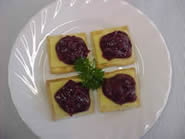What Next?

The course is a work in progress. There are still organisational details to be worked out to make it more realistic. By way of example, Kate is pondering how best to organise the sensory testing of student food products. The class was too small a sample, and using the entire school would have been too unwieldy. Kate suggests form groups may be used. A consequence of having a large manufacturer, such as Heinz Wattie's, as a client is that realistic product briefs can constrain the imagination of the more able students. Next year, the unit may include some work on packaging design to resolve this problem.
Kate may tighten up the theory lessons that begin the year and get into hands-on activities earlier. She would also like to encourage more use of workbooks during class.
"A good workbook has a few spills on it."
On the whole though, she is pleased with the level of documentation achieved this year. She facilitates achievement by providing students with a loosely indicative guide to what's required and how it should be set out at the beginning of the course. She then breaks down her teaching into appropriate milestone stages.
What particularly surprised or delighted you about the way the unit went this year?
"I loved working with Rachel. And I just loved the fact that we went into the pilot plant and made a product and the student's reaction. A really neat way to end it."
